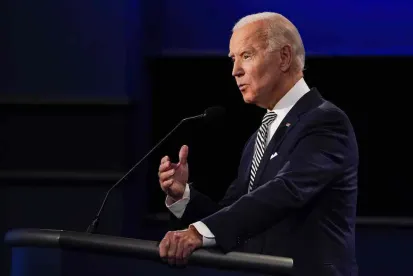On Thursday, September 9, 2021, as President Biden announced his new six-pronged plan to combat the continuing spread of COVID-19, he acknowledged, what was readily apparent from his actions and tone, that his “patience is wearing thin” with unvaccinated Americans.
Among the new measures, four of six planned actions stand out as being particularly significant for many employers. Those actions include:
-
“Requiring All Employers with 100+ Employees to Ensure their Workers are Vaccinated or Tested Weekly”
-
“Requiring Vaccinations for … Millions of Contractors that Do Business with the Federal Government”
-
“Requiring COVID-19 Vaccinations for Over 17 Million Health Care Workers at Medicare and Medicaid Participating Hospitals and Other Health Care Settings”
-
“Requiring Employers to Provide Paid Time Off to Get Vaccinated”
Issues Related to Vaccination/Testing Requirement for Employers with 100+ Employees
The first of the actions listed above is certainly the most unexpected and raises pressing questions for many employers. The requirement will be implemented by the Occupational Safety and Health Administration (OSHA) through an Emergency Temporary Standard (ETS) as provided for by Section 6(c) of the Occupational Safety and Health Act of 1970 (OSH Act).
Administration officials acknowledge that it will take a period of “weeks” for OSHA to draft the ETS that will include key details regarding what is required as well as additional guidance for employers. The ETS, which will be effective upon publication in the Federal Register, undoubtedly will provide employers with a meaningful period of time to comply with the standard.
Of note, is the fact that this rarely applied ETS provision of the OSH Act can be utilized only if certain stringent requirements are met. Accordingly, litigation will likely ensue over whether those requirements are satisfied by the current circumstances.
Specifically, under Section 6(c) of the OSH Act, the Secretary of Labor may issue an ETS only if it is determined:
(A) that employees are exposed to grave danger from exposure to substances or agents determined to be toxic or physically harmful or from new hazards, and
(B) that such emergency standard is necessary to protect employees from such danger.
(Emphasis added).
Importantly, when OSHA issues a new standard for employers, under its regular full notice and comment rulemaking process, the agency is required to establish only the existence of a “significant risk” rather than a “grave danger.” Further, under the normal rulemaking process, instead of having to prove that the new standard is categorically “necessary,” OSHA needs to establish only that the new standard is “reasonably necessary or appropriate.” In addition, an ETS can remain in effect only for a period of six months, at which time OSHA must replace it with a standard promulgated through the regular non-emergency rulemaking process.
Legal Challenges to the ETS Are Inevitable
The difficulty of establishing the ETS standard is evidenced by how seldom OSHA attempts to issue an ETS and how susceptible an ETS is to being struck down by a federal court for failure to satisfy the requisites explained above.
In fact, prior to issuing the COVID-19 prevention ETS for healthcare employers earlier this year, the agency last sought to issue an ETS in 1983 for Asbestos, and that standard was struck down by the Fifth Circuit Court of Appeals. Significantly in that decision, the appellate court cautioned OSHA that “the ETS statute is not to be used merely as an interim relief measure, but treated as an extraordinary power to be used only in ‘limited situations’ in which a grave danger exists, and then, to be ‘delicately exercised.’”
There is no doubt that in this case, there will be vigorous and immediate legal challenges to OSHA’s ETS. In addition to questioning whether the COVID-19 threat at this relatively late stage in the pandemic poses a “grave danger” and whether the action is truly “necessary,” litigation may question the blanket applicability to employers of 100+, without regard to the number of employees at a single site of employment.
We should expect that legal challenges may also focus on the fact that OSHA effectively will be requiring individuals to undergo a medical procedure. Litigation may question whether such an action oversteps the scope of authority entrusted to the agency under the OSH Act. Notably, while local governments and states have not uncommonly imposed vaccination requirements on groups of Americans (requirements which have been upheld by various courts, including the Supreme Court), OSHA has never imposed a vaccination requirement either through the ETS process or the agency’s regular rulemaking procedures.
Importantly, a legal challenge to the ETS is almost certainly not ripe until the ETS is actually issued. Thus, employers should not expect immediate action from the federal courts in either blocking or validating the President’s instruction to OSHA to develop and issue the ETS.
Key Unanswered Questions about the Vaccination/Testing Requirement
It remains to be seen whether the text of the ETS and its preamble will answer a variety of key questions, including:
-
Does the employer have to pay for the testing?
-
Does the employer have to pay employees for the time it takes to get tested?
-
What types of tests may an employer accept from an unvaccinated employee?
-
What kind of proof must an employer obtain from an employee of vaccination or testing results?
-
Will employees working from home or at an isolated location be exempted from the ETS?
-
Will any other safety mechanisms, such as masking requirements, be imposed?
-
How will OSHA monitor employer compliance with the ETS, and what penalty mechanisms will be applied?
-
Will specific guidance regarding the application of medical and religious exemptions be included in the ETS?
Which Employers Are Covered by Federal Contractor Vaccination Mandate Executive Order?
The vaccine mandate promulgated by President Biden’s Executive Order (E.O.) addressing federal contractors applies only to new contracts, new solicitations for contracts, contract extensions or renewals, and the exercise of options on contracts that, in each case, occur on or after October 15, 2021. The E.O. “strongly encourages”—but does not mandate—agencies to ensure that the safety protocols required under existing contracts follow the requirements of the E.O., to the extent permitted by law.
The E.O. applies to four types of contracts: (i) a procurement contract for services, construction, or a real property leasehold interest; (ii) a contract for services covered by the Service Contract Act, which is a contract for more than $2,500, with a principal purpose of furnishing services in the United States through the use of service employees; (iii) a contract for concessions (granting the right to use federal property/facilities for furnishing services, including contracts for providing services to the general public); and (iv) a contract in connection with Federal property or lands and related to offering services for Federal employees, their dependents, or the general public.
The E.O. specifically excludes (i) grants, (ii) contracts with Indian tribes, (iii) contracts with a value equal to or less than the simplified acquisition threshold as that term is defined under federal acquisition regulations (generally $250,000), (iv) employees who work outside the United States and (v) subcontracts solely for the provision of products.
Despite the detail in the E.O., a variety of uncertainties remain concerning precisely which contractors and employees will be covered. The E.O. requires the Administration’s “Safer Federal Workforce Task Force” to issue guidance by September 24, 2021, which will hopefully resolve most of those questions. For the duration of a covered contract, the contractor or subcontractor must comply with the published guidance.
With respect to which locations of an employer under a covered contract are subject to the E.O., the President’s directive explains that its requirements “apply to any workplace locations (as specified by the Task Force Guidance) in which an individual is working on or in connection with a Federal Government contract or contract-like instrument.” What that location standard means in practice will hopefully be clarified by the Task Force’s guidance.
Additionally, employers should hope and expect that the Task Force guidance will provide direction as to how medical and religious exemptions should applied to covered employees.
Required Vaccinations for Health Care Workers at Medicare and Medicaid Participating Healthcare Facilities May Prove to Be the Least Controversial Action by the President
The President’s requirement for vaccination of nearly 17 million healthcare workers is less likely to be subject to an effective legal challenge because of the nature of the work performed by those individuals and the long history in the United States of mandating vaccines for employees in hospitals and other healthcare settings.
This requirement announced by the President is being carried out by the federal government’s Centers for Medicare & Medicaid Services (CMS).
President’s Call for Time off for Employees to Be Vaccinated
The final element of the White House’s six-point plan of particular interest to employers is the President’s announcement that “OSHA is developing a rule that will require employers with more than 100 employees to provide paid time off for the time it takes for workers to get vaccinated or to recover if they are under the weather post-vaccination.” That requirement will be implemented through the same OSHA ETS that will establish the vaccination/testing requirement for employers with 100+ employees. Again, employers should watch for issuance of the text of that ETS and its preamble to understand the specifics of this pay requirement.





 />i
/>i
